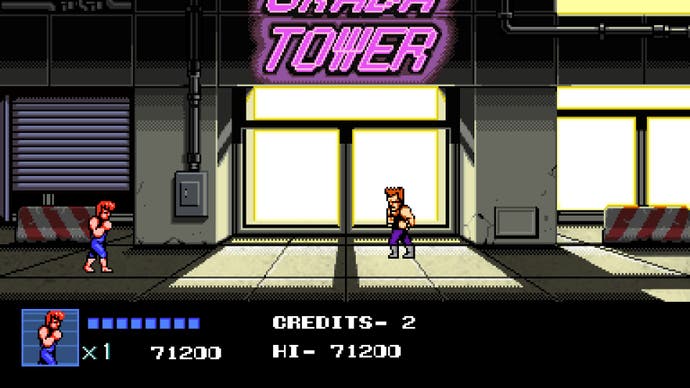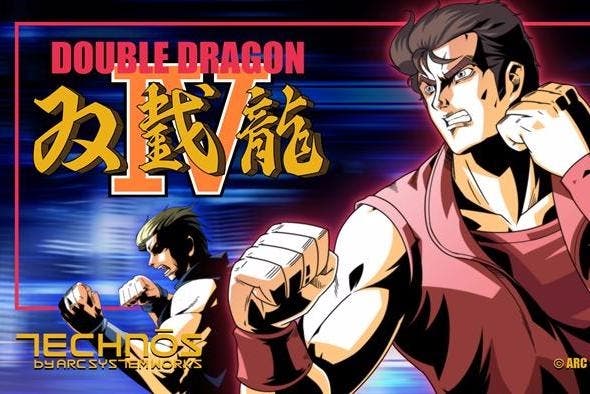Double Dragon 4 review
Mullet over.
'Keep your politics out of our games.' Behind the fretful plea (one which has recently become something of a placard slogan, waved at game developers by those who want games to offer only retreat from the real world, not a reflection of it), is the belief that a video game can stand apart from the context in which it is created. The argument collapses when you consider the myriad ways in which time and culture infuse every aspect of a video game's design from a technological standpoint.
Take the Double Dragon series' trajectory through the years. Its debut, which features American twin martial artists, Billy and Jimmy Lee, mowing their way through oncoming ranks of shuffling street thugs, appeared in arcades in 1987. The game's design and challenge was a result of this specific context: a two-player (designed to physically fit a two-player cabinet) beat 'em up which ramped up the difficulty after the first stage or two in order to maximise the machine's profits - albeit while letting players feel as though, with time, effort and enough financial investment, mastery was within reach.
Sequels followed, each one blossoming with yet greater numbers of colours, sprites and animations, as the underlying technology grew deeper and more fertile. In 1994, as the scrolling beat 'em up genre's popularity began to wane, the fifth game in the series, Double Dragon 5: The Shadow Falls, became a one-on-one fighter -- an attempt to mimic the success of Capcom's Street Fighter 2 (closely followed by another one-on-one fighter for the Neo Geo). At each step, the series was being nudged, not by an artist's vision, but by the external influence of market force and fashion. By the time of the 3D revolution in video games, some believed that the scrolling beat 'em up was due its first nostalgic revival. Technos, however, had gone out of business, leaving other companies to test the theory (as Square Enix discovered, with its lavishly produced The Bouncer, the appetite was mild).

By 2012, indie games had made 2D pixel art fashionable again. Sensing an opportunity, WayForward released Double Dragon Neon, a self-parodying take on the series, rendered in pristine, high-resolution sprites. And now, five years on, we have Double Dragon 4. The high res sprites are gone, as is the millennial sense of irony. This is, by contrast, an earnest sequel to the NES original: not a remake that takes the original material and stretching it to fit contemporary technology, but a 'demake' that intentionally overlooks the scope of contemporary technology. There are the fat sprites. There is the limited palette of moves. Bringing together the original game's designers, Yoshihisa Kishimoto and Koji Ogata, and its composer, Kazunaka Yamane, it is an attempt to revisit a lost era. It is an attempt to Make Double Dragon Great Again. It is, in other words, a very 2017 interpretation of Double Dragon, one that cannot be divorced from the context in which it was made.
There are some restrained concessions to modernity. In the mid-1990s, when Daisuke Ishiwatari developed Guilty Gear series of fighting games at Arc System Works, the developer of Double Dragon 4, he would draw the game's sprites with four times the number of pixels than any other game at the time in order to give the impression of high definition, before high definition was a thing. The trick is replicated here. To give the game the blocky feel of an NES game, each 'pixel' block is comprised of many actual constituent pixels. In this way, the game looks sharp but also antiquated. It's an elegant and effective way to give the impression of NES sprites running on a TV screen that was never intended to run NES sprites.
Other than the soundtrack, which uses many more sounds than the NES chip would allow for, this is an authentically simplistic game. There is no parallax scrolling, to give a sense of depth and horizon to the 2D backdrops. The hitboxes that determine where a character's body starts and ends appear to be chunky rectangles, invisibly superimposed onto the sprite. Enemies patiently wait for you to get to your feet after a knock down, with mannequin-challenge-esque stillness. If you walk through a doorway holding a knife, it will be gone by the time the next room loads into view. Like Oscar-nominee LaLaLand or, more precisely, Oscar-winner The Artist. Double Dragon 4 adopts not only the aesthetic but also the techniques of a disappeared age.

There are two foundational attacks: a punch, which can be strung into a jabbing combo, tailed with a haymaking uppercut and a shunting kick. These basic attacks can be combined with the jump to create either a flying or spin kick. If you're knocked to the ground, you can launch into a rising knee, or, if the bad guy is behind you, a backwards elbow, to prevent your character from being summarily pummelled on stand-up. Loose and littered objects - tyres, rocks, dagger and the lick - can be picked up from the ground and hurled at enemies, but, apart from a few arcanely executed moves (a jack-knifing head-butt; a corkscrew lunge) this is the extent of your pugilistic repertoire.
The economy, too, is lifted from another time. You have four lives and a stash of five credits. This is your allowance. Once spent, it's back to the title screen, with no level select option to skip the early sheets. The game's challenge is calibrated, not by the intelligence of the opponents you meet as you tour the docks, the hotels, the mean streets, but by their weight in numbers. Toward the end of the game you'll face off against multiple enemies at once, who can easily overwhelm. The strategy, such as it is, is to do with spacing. You knock a mid-boss to the ground on the left so that you can deal with the pair of nunchuck-wielding karate champs over on the right. You zip. You crowd manage.
Each stage is bookended with some storyline, delivered via pixelated stills and snippets of 80s action movie-dialogue. Every time you finish a stage you unlock a new character or characters to use in the game's main extra curricular mode: a two-player fight arena (where, alas, you can only face off against another human player; no AIs here). It takes a while to acclimatise to Double Dragon 4's wilfully archaic rhythm. Some players will submit to the charm spell it is trying to cast. Yet, stripped of the context of time (the 1980s) and space (the amusement arcade, where every life has a financial cost attached), that spell has been severely weakened.

